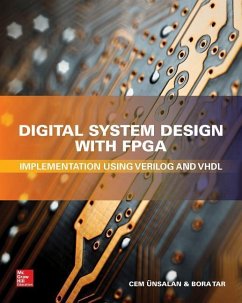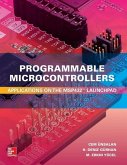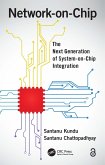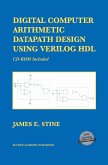- Gebundenes Buch
- Merkliste
- Auf die Merkliste
- Bewerten Bewerten
- Teilen
- Produkt teilen
- Produkterinnerung
- Produkterinnerung
Publisher's Note: Products purchased from Third Party sellers are not guaranteed by the publisher for quality, authenticity, or access to any online entitlements included with the product. Master FPGA digital system design and implementation with Verilog and VHDL This practical guide explores the development and deployment of FPGA-based digital systems using the two most popular hardware description languages, Verilog and VHDL. Written by a pair of digital circuit design experts, the book offers a solid grounding in FPGA principles, practices, and applications and provides an overview of more…mehr
Andere Kunden interessierten sich auch für
![Programmable Microcontrollers: Applications on the Msp432 Launchpad Programmable Microcontrollers: Applications on the Msp432 Launchpad]() Cem UnsalanProgrammable Microcontrollers: Applications on the Msp432 Launchpad98,99 €
Cem UnsalanProgrammable Microcontrollers: Applications on the Msp432 Launchpad98,99 €![Digital Logic Design and Computer Organization with Computer Architecture for Security Digital Logic Design and Computer Organization with Computer Architecture for Security]() Nikrouz FaroughiDigital Logic Design and Computer Organization with Computer Architecture for Security180,99 €
Nikrouz FaroughiDigital Logic Design and Computer Organization with Computer Architecture for Security180,99 €![Fundamentals of Digital Logic with Verilog Design Fundamentals of Digital Logic with Verilog Design]() Stephen BrownFundamentals of Digital Logic with Verilog Design279,99 €
Stephen BrownFundamentals of Digital Logic with Verilog Design279,99 €![Network-On-Chip Network-On-Chip]() Santanu KunduNetwork-On-Chip214,99 €
Santanu KunduNetwork-On-Chip214,99 €![Open Systems Dependability Open Systems Dependability]() Open Systems Dependability160,99 €
Open Systems Dependability160,99 €![Digital Computer Arithmetic Datapath Design Using Verilog Hdl Digital Computer Arithmetic Datapath Design Using Verilog Hdl]() James E. StineDigital Computer Arithmetic Datapath Design Using Verilog Hdl123,99 €
James E. StineDigital Computer Arithmetic Datapath Design Using Verilog Hdl123,99 €![Introduction to Logic Design Introduction to Logic Design]() Alan B MarcovitzIntroduction to Logic Design292,99 €
Alan B MarcovitzIntroduction to Logic Design292,99 €-
-
-
Publisher's Note: Products purchased from Third Party sellers are not guaranteed by the publisher for quality, authenticity, or access to any online entitlements included with the product. Master FPGA digital system design and implementation with Verilog and VHDL This practical guide explores the development and deployment of FPGA-based digital systems using the two most popular hardware description languages, Verilog and VHDL. Written by a pair of digital circuit design experts, the book offers a solid grounding in FPGA principles, practices, and applications and provides an overview of more complex topics. Important concepts are demonstrated through real-world examples, ready-to-run code, and inexpensive start-to-finish projects for both the Basys and Arty boards. Digital System Design with FPGA: Implementation Using Verilog and VHDL covers: . Field programmable gate array fundamentals . Basys and Arty FPGA boards . The Vivado design suite . Verilog and VHDL . Data types and operators . Combinational circuits and circuit blocks . Data storage elements and sequential circuits . Soft-core microcontroller and digital interfacing . Advanced FPGA applications . The future of FPGA "I joined Xilinx five years ago and have looked for a good, introductory book on FPGA-based design ever since because people have repeatedly asked me for my recommendation. Today, I found a brand new book to recommend to people wanting to learn about using programmable logic to design digital systems. It's titled - Digital Systems Design with FPGA: Implementation Using Verilog and VHDL and...[it] will take you from the basics of digital design and logic into FPGAs; FPGA architecture including programmable logic, block RAM, DSP slices, FPGA clock management, and programmable I/O; hardware description languages with an equal emphasis on Verilog and VHDL; the Xilinx Vivado Design Environment; and then on to IP cores including the Xilinx MicroBlaze and PicoBlaze soft processors. The book ends with 24 advanced embedded design projects." - Steve Leibson, Xcell Daily Blog
Hinweis: Dieser Artikel kann nur an eine deutsche Lieferadresse ausgeliefert werden.
Hinweis: Dieser Artikel kann nur an eine deutsche Lieferadresse ausgeliefert werden.
Produktdetails
- Produktdetails
- Verlag: McGraw-Hill Education
- Seitenzahl: 402
- Erscheinungstermin: 10. Juli 2017
- Englisch
- Abmessung: 241mm x 196mm x 26mm
- Gewicht: 942g
- ISBN-13: 9781259837906
- ISBN-10: 1259837904
- Artikelnr.: 46511805
- Herstellerkennzeichnung
- Libri GmbH
- Europaallee 1
- 36244 Bad Hersfeld
- gpsr@libri.de
- Verlag: McGraw-Hill Education
- Seitenzahl: 402
- Erscheinungstermin: 10. Juli 2017
- Englisch
- Abmessung: 241mm x 196mm x 26mm
- Gewicht: 942g
- ISBN-13: 9781259837906
- ISBN-10: 1259837904
- Artikelnr.: 46511805
- Herstellerkennzeichnung
- Libri GmbH
- Europaallee 1
- 36244 Bad Hersfeld
- gpsr@libri.de
Cem Ünsalan, Ph.D. established the DSP Laboratory and is a microprocessor and digital signal processing instructor. He is the author of Programmable Microcontrollers with Applications: MSP430 LaunchPad with CSS and Grace. Bora Tar, Ph.D. is a postdoctoral researcher at The Ohio State University. His main research interests include analog and mixed signal integrated-circuit design and energy harvesting and sensor networking applications.
1 Introduction
1.1 Hardware Description Languages
1.2 FPGA Boards and Software Tools
1.3 Topics to Be Covered in the Book
2 Field-Programmable Gate Arrays
2.1 A Brief Introduction to Digital Electronics
2.1.1 Bit Values as Voltage Levels
2.1.2 Transistor as a Switch
2.1.3 Logic Gates from Switches
2.2 FPGA Building Blocks
2.2.1 Layout of the Xilinx Artix-7 XC7A35T FPGA
2.2.2 Input/Output Blocks
2.2.3 Configurable Logic Blocks
2.2.4 Interconnect Resources
2.2.5 Block RAM
2.2.6 DSP Slices
2.2.7 Clock Management
2.2.8 The XADC Block
2.2.9 High-Speed Serial I/O Transceivers
2.2.10 Peripheral Component Interconnect Express Interface
2.3 FPGA-Based Digital System Design Philosophy
2.3.1 How to Think While Using FPGAs
2.3.2 Advantages and Disadvantages of FPGAs
2.4 Usage Areas of FPGAs
2.5 Summary
2.6 Exercises
3 Basys3 and Arty FPGA Boards
3.1 The Basys3 Board
3.1.1 Powering the Board
3.1.2 Input/Output
3.1.3 Configuring the FPGA
3.1.4 Advanced Connectors
3.1.5 External Memory
3.1.6 Oscillator/Clock
3.2 The Arty Board
3.2.1 Powering the Board
3.2.2 Input/Output
3.2.3 Configuring the FPGA
3.2.4 Advanced Connectors
3.2.5 External Memory
3.2.6 Oscillator/Clock
3.3 Summary
3.4 Exercises
4 The Vivado Design Suite
4.1 Installation and the Welcome Screen
4.2 Creating a New Project
4.2.1 Adding a Verilog File
4.2.2 Adding a VHDL File
4.3 Synthesizing the Project
4.4 Simulating the Project
4.4.1 Adding a Verilog Testbench File
4.4.2 Adding a VHDL Testbench File
4.5 Implementing the Synthesized Project
4.6 Programming the FPGA
4.6.1 Adding the Basys3 Board Constraint File to the Project
4.6.2 Programming the FPGA on the Basys3 Board
4.6.3 Adding the Arty Board Constraint File to the Project
4.6.4 Programming the FPGA on the Arty Board
4.7 Vivado Design Suite IP Management
4.7.1 Existing IP Blocks in Vivado
4.7.2 Generating a Custom IP
4.8 Application on the Vivado Design Suite
4.9 Summary
4.10 Exercises
5 Introduction to Verilog and VHDL
5.1 Verilog Fundamentals
5.1.1 Module Representation
5.1.2 Timing and Delays in Modeling
5.1.3 Hierarchical Module Representation
5.2 Testbench Formation in Verilog
5.2.1 Structure of a Verilog Testbench File
5.2.2 Displaying Test Results
5.3 VHDL Fundamentals
5.3.1 Entity and Architecture Representations
5.3.2 Dataflow Modeling
5.3.3 Behavioral Modeling
5.3.4 Timing and Delays in Modeling
5.3.5 Hierarchical Structural Representation
5.4 Testbench Formation in VHDL
5.4.1 Structure of a VHDL Testbench File
5.4.2 Displaying Test Results
5.5 Adding an Existing IP to the Project
5.5.1 Adding an Existing IP in Verilog
5.5.2 Adding an Existing IP in VHDL
5.6 Summary
5.7 Exercises
6 Data Types and Operators
6.1 Number Representations
6.1.1 Binary Numbers
6.1.2 Octal Numbers
6.1.3 Hexadecimal Numbers
6.2 Negative Numbers
6.2.1 Signed Bit Representation
6.2.2 One's Complement Representation
6.2.3 Two's Complement Representation
6.3 Fixed- and Floating-Point Representations
6.3.1 Fixed-Point Representation
6.3.2 Floating-Point Representation
6.4 ASCII Code
6.5 Arithmetic Operations on Binary Numbers
6.5.1 Addition
6.5.2 Subtraction
6.5.3 Multiplication
6.5.4 Division
6.6 Data Types in Verilog
6.6.1 Net and Variable Data Types
6.6.2 Data Values
6.6.3 Naming a Net or Variable
6.6.4 Defining Constants and Parameters
6.6.5 Defining Vectors
6.7 Operators in Verilog
6.7.1 Arithmetic Operators
6.7.2 Concatenation and Replication Operators
6.8 Data Types in VHDL
6.8.1 Signal and Variable Data Types
6.8.2 Data Values
6.8.3 Naming a Signal or Variable
6.8.4 Defining Constants
6.8.5 Defining Arrays
6.9 Operators in VHDL
6.9.1 Arithmetic Operators
6.9.2 Concatenation Operator
6.10 Application on Data Types and Operators
6.11 FPGA Building Blocks Used in Data Types and Operators
6.11.1 Implementation Details of Vector Operations
6.11.2 Implementation Details of Arithmetic Operations
6.12 Summary
6.13 Exercises
7 Combinational Circuits
7.1 Basic Definitions
7.1.1 Binary Variable
7.1.2 Logic Function
7.1.3 Truth Table
7.2 Logic Gates
7.2.1 The NOT Gate
7.2.2 The OR Gate
7.2.3 The AND Gate
7.2.4 The XOR Gate
7.3 Combinational Circuit Analysis
7.3.1 Logic Function Formation between Input and Output
7.3.2 Boolean Algebra
7.3.3 Gate-Level Minimization
7.4 Combinational Circuit Implementation
7.4.1 Truth Table-Based Implementation
7.4.2 Implementing One-Input Combinational Circuits
7.4.3 Implementing Two-Input Combinational Circuits
7.4.4 Implementing Three-Input Combinational Circuits
7.5 Combinational Circuit Design
7.5.1 Analyzing the Problem to Be Solved
7.5.2 Selecting a Solution Method
7.5.3 Implementing the Solution
7.6 Sample Designs
7.6.1 Home Alarm System
7.6.2 Digital Safe System
7.6.3 Car Park Occupied Slot Counting System
7.7 Applications on Combinational Circuits
7.7.1 Implementing the Home Alarm System
7.7.2 Implementing the Digital Safe System
7.7.3 Implementing the Car Park Occupied Slot Counting System
7.8 FPGA Building Blocks Used in Combinational Circuits
7.9 Summary
7.10 Exercises
8 Combinational Circuit Blocks
8.1 Adders
8.1.1 Half Adder
8.1.2 Full Adder
8.1.3 Adders in Verilog
8.1.4 Adders in VHD
8.2 Comparators
8.2.1 Comparators in Verilog
8.2.2 Comparators in VHDL
8.3 Decoders
8.3.1 Decoders in Verilog
8.3.2 Decoders in VHDL
8.4 Encoders
8.4.1 Encoders in Verilog
8.4.2 Encoders in VHDL
8.5 Multiplexers
8.5.1 Multiplexers in Verilog
8.5.2 Multiplexers in VHDL
8.6 Parity Generators and Checkers
8.6.1 Parity Generators
8.6.2 Parity Checkers
8.6.3 Parity Generators and Checkers in Verilog
8.6.4 Parity Generators and Checkers in VHDL
8.7 Applications on Combinational Circuit Blocks
8.7.1 Improving the Calculator
8.7.2 Improving the Home Alarm System
8.7.3 Improving the Car Park Occupied Slot Counting System
8.8 FPGA Building Blocks Used in Combinational Circuit Blocks
8.9 Summary
8.10 Exercises
9 Data Storage Elements
9.1 Latches
9.1.1 SR Latch
9.1.2 D Latch
9.1.3 Latches in Verilog
9.1.4 Latches in VHDL
9.2 Flip-Flops
9.2.1 D Flip-Flop
9.2.2 JK Flip-Flop
9.2.3 T Flip-Flop
9.2.4 Flip-Flops in Verilog
9.2.5 Flip-Flops in VHDL
9.3 Register
9.4 Memory
9.5 Read-Only Memory
9.5.1 ROM in Verilog
9.5.2 ROM in VHDL
9.5.3 ROM Formation Using IP Blocks
9.6 Random Access Memory
9.7 Application on Data Storage Elements
9.8 FPGA Building Blocks Used in Data Storage Elements
9.9 Summary
9.10 Exercises
10 Sequential Circuits
10.1 Sequential Circuit Analysis
10.1.1 Definition of State
10.1.2 State and Output Equations
10.1.3 State Table
10.1.4 State Diagram
10.1.5 State Representation in Verilog
10.1.6 State Representation in VHDL
10.2 Timing in Sequential Circuits
10.2.1 Synchronous Operation
10.2.2 Asynchronous Operation
10.3 Shift Register as a Sequential Circuit
10.3.1 Shift Registers in Verilog
10.3.2 Shift Registers in VHDL
10.3.3 Multiplication and Division Using Shift Registers
10.4 Counter as a Sequential Circuit
10.4.1 Synchronous Counter
10.4.2 Asynchronous Counter
10.4.3 Counters in Verilog
10.4.4 Counters in VHDL
10.4.5 Frequency Division Using Counters
10.5 Sequential Circuit Design
10.6 Applications on Sequential Circuits
10.6.1 Improving the Home Alarm System
10.6.2 Improving the Digital Safe System
10.6.3 Improving the Car Park Occupied Slot Counting System
10.6.4 Vending Machine
10.6.5 Digital Clock
10.7 FPGA Building Blocks Used in Sequential Circuits
10.8 Summary
10.9 Exercises
11 Embedding a Soft-Core Microcontroller
11.1 Building Blocks of a Generic Microcontroller
11.1.1 Central Processing Unit
11.1.2 Arithmetic Logic Unit
11.1.3 Memory
11.1.4 Oscillator/Clock
11.1.5 General Purpose Input/Output
11.1.6 Other Blocks
11.2 Xilinx PicoBlaze Microcontroller
11.2.1 Functional Blocks of PicoBlaze
11.2.2 PicoBlaze in Verilog
11.2.3 PicoBlaze in VHDL
11.2.4 PicoBlaze Application on the Basys3 Board
11.3 Xilinx MicroBlaze Microcontroller
11.3.1 MicroBlaze as an IP Block in Vivado
11.3.2 MicroBlaze MCS Application on the Basys3 Board
11.4 Soft-Core Microcontroller Applications
11.5 FPGA Building Blocks Used in Soft-Core Microcontrollers
11.6 Summary
11.7 Exercises
12 Digital Interfacing
12.1 Universal Asynchronous Receiver/Transmitter
12.1.1 Working Principles of UART
12.1.2 UART in Verilog
12.1.3 UART in VHDL
12.1.4 UART Applications
12.2 Serial Peripheral Interface
12.2.1 Working Principles of SPI
12.2.2 SPI in Verilog
12.2.3 SPI in VHDL
12.2.4 SPI Application
12.3 Inter-Integrated Circuit
12.3.1 Working Principles of I2C
12.3.2 I2C in Verilog
12.3.3 I2C in VHDL
12.3.4 I2C Application
12.4 Video Graphics Array
12.4.1 Working Principles of VGA
12.4.2 VGA in Verilog
12.4.3 VGA in VHDL
12.4.4 VGA Application
12.5 Universal Serial Bus
12.5.1 USB-Receiving Module in Verilog
12.5.2 USB-Receiving Module in VHDL
12.5.3 USB Keyboard Application
12.6 Ethernet
12.7 FPGA Building Blocks Used in Digital Interfacing
12.8 Summary
12.9 Exercises
13 Advanced Appl ications
13.1 Integrated Logic Analyzer IP Core Usage
13.2 The XADC Block Usage
13.3 Adding Two Floating-Point Numbers
13.4 Calculator
13.5 Home Alarm System
13.6 Digital Safe System
13.7 Car Park Occupied Slot Counting System
13.8 Vending Machine
13.9 Digital Clock
13.10 Moving Wave via LEDs
13.11 Translator
13.12 Air Freshener Dispenser
13.13 Obstacle-Avoiding Tank
13.14 Intelligent Washing Machine
13.15 Non-Touch Paper Towel Dispenser
13.16 Traffic Lights
13.17 Car Parking Sensor System
13.18 Body Weight Scale
13.19 Intelligent Billboard
13.20 Elevator Cabin Control System
13.21 Digital Table Tennis Game
13.22 Customer Counter
13.23 Frequency Meter
13.24 Pedometer
14 What Is Next?
14.1 Vivado High-Level Synthesis Platform
14.2 Developing a Project in Vivado HLS to Generate IP
14.3 Using the Generated IP in Vivado
14.4 Summary
14.5 Exercises
References
Index
1.1 Hardware Description Languages
1.2 FPGA Boards and Software Tools
1.3 Topics to Be Covered in the Book
2 Field-Programmable Gate Arrays
2.1 A Brief Introduction to Digital Electronics
2.1.1 Bit Values as Voltage Levels
2.1.2 Transistor as a Switch
2.1.3 Logic Gates from Switches
2.2 FPGA Building Blocks
2.2.1 Layout of the Xilinx Artix-7 XC7A35T FPGA
2.2.2 Input/Output Blocks
2.2.3 Configurable Logic Blocks
2.2.4 Interconnect Resources
2.2.5 Block RAM
2.2.6 DSP Slices
2.2.7 Clock Management
2.2.8 The XADC Block
2.2.9 High-Speed Serial I/O Transceivers
2.2.10 Peripheral Component Interconnect Express Interface
2.3 FPGA-Based Digital System Design Philosophy
2.3.1 How to Think While Using FPGAs
2.3.2 Advantages and Disadvantages of FPGAs
2.4 Usage Areas of FPGAs
2.5 Summary
2.6 Exercises
3 Basys3 and Arty FPGA Boards
3.1 The Basys3 Board
3.1.1 Powering the Board
3.1.2 Input/Output
3.1.3 Configuring the FPGA
3.1.4 Advanced Connectors
3.1.5 External Memory
3.1.6 Oscillator/Clock
3.2 The Arty Board
3.2.1 Powering the Board
3.2.2 Input/Output
3.2.3 Configuring the FPGA
3.2.4 Advanced Connectors
3.2.5 External Memory
3.2.6 Oscillator/Clock
3.3 Summary
3.4 Exercises
4 The Vivado Design Suite
4.1 Installation and the Welcome Screen
4.2 Creating a New Project
4.2.1 Adding a Verilog File
4.2.2 Adding a VHDL File
4.3 Synthesizing the Project
4.4 Simulating the Project
4.4.1 Adding a Verilog Testbench File
4.4.2 Adding a VHDL Testbench File
4.5 Implementing the Synthesized Project
4.6 Programming the FPGA
4.6.1 Adding the Basys3 Board Constraint File to the Project
4.6.2 Programming the FPGA on the Basys3 Board
4.6.3 Adding the Arty Board Constraint File to the Project
4.6.4 Programming the FPGA on the Arty Board
4.7 Vivado Design Suite IP Management
4.7.1 Existing IP Blocks in Vivado
4.7.2 Generating a Custom IP
4.8 Application on the Vivado Design Suite
4.9 Summary
4.10 Exercises
5 Introduction to Verilog and VHDL
5.1 Verilog Fundamentals
5.1.1 Module Representation
5.1.2 Timing and Delays in Modeling
5.1.3 Hierarchical Module Representation
5.2 Testbench Formation in Verilog
5.2.1 Structure of a Verilog Testbench File
5.2.2 Displaying Test Results
5.3 VHDL Fundamentals
5.3.1 Entity and Architecture Representations
5.3.2 Dataflow Modeling
5.3.3 Behavioral Modeling
5.3.4 Timing and Delays in Modeling
5.3.5 Hierarchical Structural Representation
5.4 Testbench Formation in VHDL
5.4.1 Structure of a VHDL Testbench File
5.4.2 Displaying Test Results
5.5 Adding an Existing IP to the Project
5.5.1 Adding an Existing IP in Verilog
5.5.2 Adding an Existing IP in VHDL
5.6 Summary
5.7 Exercises
6 Data Types and Operators
6.1 Number Representations
6.1.1 Binary Numbers
6.1.2 Octal Numbers
6.1.3 Hexadecimal Numbers
6.2 Negative Numbers
6.2.1 Signed Bit Representation
6.2.2 One's Complement Representation
6.2.3 Two's Complement Representation
6.3 Fixed- and Floating-Point Representations
6.3.1 Fixed-Point Representation
6.3.2 Floating-Point Representation
6.4 ASCII Code
6.5 Arithmetic Operations on Binary Numbers
6.5.1 Addition
6.5.2 Subtraction
6.5.3 Multiplication
6.5.4 Division
6.6 Data Types in Verilog
6.6.1 Net and Variable Data Types
6.6.2 Data Values
6.6.3 Naming a Net or Variable
6.6.4 Defining Constants and Parameters
6.6.5 Defining Vectors
6.7 Operators in Verilog
6.7.1 Arithmetic Operators
6.7.2 Concatenation and Replication Operators
6.8 Data Types in VHDL
6.8.1 Signal and Variable Data Types
6.8.2 Data Values
6.8.3 Naming a Signal or Variable
6.8.4 Defining Constants
6.8.5 Defining Arrays
6.9 Operators in VHDL
6.9.1 Arithmetic Operators
6.9.2 Concatenation Operator
6.10 Application on Data Types and Operators
6.11 FPGA Building Blocks Used in Data Types and Operators
6.11.1 Implementation Details of Vector Operations
6.11.2 Implementation Details of Arithmetic Operations
6.12 Summary
6.13 Exercises
7 Combinational Circuits
7.1 Basic Definitions
7.1.1 Binary Variable
7.1.2 Logic Function
7.1.3 Truth Table
7.2 Logic Gates
7.2.1 The NOT Gate
7.2.2 The OR Gate
7.2.3 The AND Gate
7.2.4 The XOR Gate
7.3 Combinational Circuit Analysis
7.3.1 Logic Function Formation between Input and Output
7.3.2 Boolean Algebra
7.3.3 Gate-Level Minimization
7.4 Combinational Circuit Implementation
7.4.1 Truth Table-Based Implementation
7.4.2 Implementing One-Input Combinational Circuits
7.4.3 Implementing Two-Input Combinational Circuits
7.4.4 Implementing Three-Input Combinational Circuits
7.5 Combinational Circuit Design
7.5.1 Analyzing the Problem to Be Solved
7.5.2 Selecting a Solution Method
7.5.3 Implementing the Solution
7.6 Sample Designs
7.6.1 Home Alarm System
7.6.2 Digital Safe System
7.6.3 Car Park Occupied Slot Counting System
7.7 Applications on Combinational Circuits
7.7.1 Implementing the Home Alarm System
7.7.2 Implementing the Digital Safe System
7.7.3 Implementing the Car Park Occupied Slot Counting System
7.8 FPGA Building Blocks Used in Combinational Circuits
7.9 Summary
7.10 Exercises
8 Combinational Circuit Blocks
8.1 Adders
8.1.1 Half Adder
8.1.2 Full Adder
8.1.3 Adders in Verilog
8.1.4 Adders in VHD
8.2 Comparators
8.2.1 Comparators in Verilog
8.2.2 Comparators in VHDL
8.3 Decoders
8.3.1 Decoders in Verilog
8.3.2 Decoders in VHDL
8.4 Encoders
8.4.1 Encoders in Verilog
8.4.2 Encoders in VHDL
8.5 Multiplexers
8.5.1 Multiplexers in Verilog
8.5.2 Multiplexers in VHDL
8.6 Parity Generators and Checkers
8.6.1 Parity Generators
8.6.2 Parity Checkers
8.6.3 Parity Generators and Checkers in Verilog
8.6.4 Parity Generators and Checkers in VHDL
8.7 Applications on Combinational Circuit Blocks
8.7.1 Improving the Calculator
8.7.2 Improving the Home Alarm System
8.7.3 Improving the Car Park Occupied Slot Counting System
8.8 FPGA Building Blocks Used in Combinational Circuit Blocks
8.9 Summary
8.10 Exercises
9 Data Storage Elements
9.1 Latches
9.1.1 SR Latch
9.1.2 D Latch
9.1.3 Latches in Verilog
9.1.4 Latches in VHDL
9.2 Flip-Flops
9.2.1 D Flip-Flop
9.2.2 JK Flip-Flop
9.2.3 T Flip-Flop
9.2.4 Flip-Flops in Verilog
9.2.5 Flip-Flops in VHDL
9.3 Register
9.4 Memory
9.5 Read-Only Memory
9.5.1 ROM in Verilog
9.5.2 ROM in VHDL
9.5.3 ROM Formation Using IP Blocks
9.6 Random Access Memory
9.7 Application on Data Storage Elements
9.8 FPGA Building Blocks Used in Data Storage Elements
9.9 Summary
9.10 Exercises
10 Sequential Circuits
10.1 Sequential Circuit Analysis
10.1.1 Definition of State
10.1.2 State and Output Equations
10.1.3 State Table
10.1.4 State Diagram
10.1.5 State Representation in Verilog
10.1.6 State Representation in VHDL
10.2 Timing in Sequential Circuits
10.2.1 Synchronous Operation
10.2.2 Asynchronous Operation
10.3 Shift Register as a Sequential Circuit
10.3.1 Shift Registers in Verilog
10.3.2 Shift Registers in VHDL
10.3.3 Multiplication and Division Using Shift Registers
10.4 Counter as a Sequential Circuit
10.4.1 Synchronous Counter
10.4.2 Asynchronous Counter
10.4.3 Counters in Verilog
10.4.4 Counters in VHDL
10.4.5 Frequency Division Using Counters
10.5 Sequential Circuit Design
10.6 Applications on Sequential Circuits
10.6.1 Improving the Home Alarm System
10.6.2 Improving the Digital Safe System
10.6.3 Improving the Car Park Occupied Slot Counting System
10.6.4 Vending Machine
10.6.5 Digital Clock
10.7 FPGA Building Blocks Used in Sequential Circuits
10.8 Summary
10.9 Exercises
11 Embedding a Soft-Core Microcontroller
11.1 Building Blocks of a Generic Microcontroller
11.1.1 Central Processing Unit
11.1.2 Arithmetic Logic Unit
11.1.3 Memory
11.1.4 Oscillator/Clock
11.1.5 General Purpose Input/Output
11.1.6 Other Blocks
11.2 Xilinx PicoBlaze Microcontroller
11.2.1 Functional Blocks of PicoBlaze
11.2.2 PicoBlaze in Verilog
11.2.3 PicoBlaze in VHDL
11.2.4 PicoBlaze Application on the Basys3 Board
11.3 Xilinx MicroBlaze Microcontroller
11.3.1 MicroBlaze as an IP Block in Vivado
11.3.2 MicroBlaze MCS Application on the Basys3 Board
11.4 Soft-Core Microcontroller Applications
11.5 FPGA Building Blocks Used in Soft-Core Microcontrollers
11.6 Summary
11.7 Exercises
12 Digital Interfacing
12.1 Universal Asynchronous Receiver/Transmitter
12.1.1 Working Principles of UART
12.1.2 UART in Verilog
12.1.3 UART in VHDL
12.1.4 UART Applications
12.2 Serial Peripheral Interface
12.2.1 Working Principles of SPI
12.2.2 SPI in Verilog
12.2.3 SPI in VHDL
12.2.4 SPI Application
12.3 Inter-Integrated Circuit
12.3.1 Working Principles of I2C
12.3.2 I2C in Verilog
12.3.3 I2C in VHDL
12.3.4 I2C Application
12.4 Video Graphics Array
12.4.1 Working Principles of VGA
12.4.2 VGA in Verilog
12.4.3 VGA in VHDL
12.4.4 VGA Application
12.5 Universal Serial Bus
12.5.1 USB-Receiving Module in Verilog
12.5.2 USB-Receiving Module in VHDL
12.5.3 USB Keyboard Application
12.6 Ethernet
12.7 FPGA Building Blocks Used in Digital Interfacing
12.8 Summary
12.9 Exercises
13 Advanced Appl ications
13.1 Integrated Logic Analyzer IP Core Usage
13.2 The XADC Block Usage
13.3 Adding Two Floating-Point Numbers
13.4 Calculator
13.5 Home Alarm System
13.6 Digital Safe System
13.7 Car Park Occupied Slot Counting System
13.8 Vending Machine
13.9 Digital Clock
13.10 Moving Wave via LEDs
13.11 Translator
13.12 Air Freshener Dispenser
13.13 Obstacle-Avoiding Tank
13.14 Intelligent Washing Machine
13.15 Non-Touch Paper Towel Dispenser
13.16 Traffic Lights
13.17 Car Parking Sensor System
13.18 Body Weight Scale
13.19 Intelligent Billboard
13.20 Elevator Cabin Control System
13.21 Digital Table Tennis Game
13.22 Customer Counter
13.23 Frequency Meter
13.24 Pedometer
14 What Is Next?
14.1 Vivado High-Level Synthesis Platform
14.2 Developing a Project in Vivado HLS to Generate IP
14.3 Using the Generated IP in Vivado
14.4 Summary
14.5 Exercises
References
Index
1 Introduction
1.1 Hardware Description Languages
1.2 FPGA Boards and Software Tools
1.3 Topics to Be Covered in the Book
2 Field-Programmable Gate Arrays
2.1 A Brief Introduction to Digital Electronics
2.1.1 Bit Values as Voltage Levels
2.1.2 Transistor as a Switch
2.1.3 Logic Gates from Switches
2.2 FPGA Building Blocks
2.2.1 Layout of the Xilinx Artix-7 XC7A35T FPGA
2.2.2 Input/Output Blocks
2.2.3 Configurable Logic Blocks
2.2.4 Interconnect Resources
2.2.5 Block RAM
2.2.6 DSP Slices
2.2.7 Clock Management
2.2.8 The XADC Block
2.2.9 High-Speed Serial I/O Transceivers
2.2.10 Peripheral Component Interconnect Express Interface
2.3 FPGA-Based Digital System Design Philosophy
2.3.1 How to Think While Using FPGAs
2.3.2 Advantages and Disadvantages of FPGAs
2.4 Usage Areas of FPGAs
2.5 Summary
2.6 Exercises
3 Basys3 and Arty FPGA Boards
3.1 The Basys3 Board
3.1.1 Powering the Board
3.1.2 Input/Output
3.1.3 Configuring the FPGA
3.1.4 Advanced Connectors
3.1.5 External Memory
3.1.6 Oscillator/Clock
3.2 The Arty Board
3.2.1 Powering the Board
3.2.2 Input/Output
3.2.3 Configuring the FPGA
3.2.4 Advanced Connectors
3.2.5 External Memory
3.2.6 Oscillator/Clock
3.3 Summary
3.4 Exercises
4 The Vivado Design Suite
4.1 Installation and the Welcome Screen
4.2 Creating a New Project
4.2.1 Adding a Verilog File
4.2.2 Adding a VHDL File
4.3 Synthesizing the Project
4.4 Simulating the Project
4.4.1 Adding a Verilog Testbench File
4.4.2 Adding a VHDL Testbench File
4.5 Implementing the Synthesized Project
4.6 Programming the FPGA
4.6.1 Adding the Basys3 Board Constraint File to the Project
4.6.2 Programming the FPGA on the Basys3 Board
4.6.3 Adding the Arty Board Constraint File to the Project
4.6.4 Programming the FPGA on the Arty Board
4.7 Vivado Design Suite IP Management
4.7.1 Existing IP Blocks in Vivado
4.7.2 Generating a Custom IP
4.8 Application on the Vivado Design Suite
4.9 Summary
4.10 Exercises
5 Introduction to Verilog and VHDL
5.1 Verilog Fundamentals
5.1.1 Module Representation
5.1.2 Timing and Delays in Modeling
5.1.3 Hierarchical Module Representation
5.2 Testbench Formation in Verilog
5.2.1 Structure of a Verilog Testbench File
5.2.2 Displaying Test Results
5.3 VHDL Fundamentals
5.3.1 Entity and Architecture Representations
5.3.2 Dataflow Modeling
5.3.3 Behavioral Modeling
5.3.4 Timing and Delays in Modeling
5.3.5 Hierarchical Structural Representation
5.4 Testbench Formation in VHDL
5.4.1 Structure of a VHDL Testbench File
5.4.2 Displaying Test Results
5.5 Adding an Existing IP to the Project
5.5.1 Adding an Existing IP in Verilog
5.5.2 Adding an Existing IP in VHDL
5.6 Summary
5.7 Exercises
6 Data Types and Operators
6.1 Number Representations
6.1.1 Binary Numbers
6.1.2 Octal Numbers
6.1.3 Hexadecimal Numbers
6.2 Negative Numbers
6.2.1 Signed Bit Representation
6.2.2 One's Complement Representation
6.2.3 Two's Complement Representation
6.3 Fixed- and Floating-Point Representations
6.3.1 Fixed-Point Representation
6.3.2 Floating-Point Representation
6.4 ASCII Code
6.5 Arithmetic Operations on Binary Numbers
6.5.1 Addition
6.5.2 Subtraction
6.5.3 Multiplication
6.5.4 Division
6.6 Data Types in Verilog
6.6.1 Net and Variable Data Types
6.6.2 Data Values
6.6.3 Naming a Net or Variable
6.6.4 Defining Constants and Parameters
6.6.5 Defining Vectors
6.7 Operators in Verilog
6.7.1 Arithmetic Operators
6.7.2 Concatenation and Replication Operators
6.8 Data Types in VHDL
6.8.1 Signal and Variable Data Types
6.8.2 Data Values
6.8.3 Naming a Signal or Variable
6.8.4 Defining Constants
6.8.5 Defining Arrays
6.9 Operators in VHDL
6.9.1 Arithmetic Operators
6.9.2 Concatenation Operator
6.10 Application on Data Types and Operators
6.11 FPGA Building Blocks Used in Data Types and Operators
6.11.1 Implementation Details of Vector Operations
6.11.2 Implementation Details of Arithmetic Operations
6.12 Summary
6.13 Exercises
7 Combinational Circuits
7.1 Basic Definitions
7.1.1 Binary Variable
7.1.2 Logic Function
7.1.3 Truth Table
7.2 Logic Gates
7.2.1 The NOT Gate
7.2.2 The OR Gate
7.2.3 The AND Gate
7.2.4 The XOR Gate
7.3 Combinational Circuit Analysis
7.3.1 Logic Function Formation between Input and Output
7.3.2 Boolean Algebra
7.3.3 Gate-Level Minimization
7.4 Combinational Circuit Implementation
7.4.1 Truth Table-Based Implementation
7.4.2 Implementing One-Input Combinational Circuits
7.4.3 Implementing Two-Input Combinational Circuits
7.4.4 Implementing Three-Input Combinational Circuits
7.5 Combinational Circuit Design
7.5.1 Analyzing the Problem to Be Solved
7.5.2 Selecting a Solution Method
7.5.3 Implementing the Solution
7.6 Sample Designs
7.6.1 Home Alarm System
7.6.2 Digital Safe System
7.6.3 Car Park Occupied Slot Counting System
7.7 Applications on Combinational Circuits
7.7.1 Implementing the Home Alarm System
7.7.2 Implementing the Digital Safe System
7.7.3 Implementing the Car Park Occupied Slot Counting System
7.8 FPGA Building Blocks Used in Combinational Circuits
7.9 Summary
7.10 Exercises
8 Combinational Circuit Blocks
8.1 Adders
8.1.1 Half Adder
8.1.2 Full Adder
8.1.3 Adders in Verilog
8.1.4 Adders in VHD
8.2 Comparators
8.2.1 Comparators in Verilog
8.2.2 Comparators in VHDL
8.3 Decoders
8.3.1 Decoders in Verilog
8.3.2 Decoders in VHDL
8.4 Encoders
8.4.1 Encoders in Verilog
8.4.2 Encoders in VHDL
8.5 Multiplexers
8.5.1 Multiplexers in Verilog
8.5.2 Multiplexers in VHDL
8.6 Parity Generators and Checkers
8.6.1 Parity Generators
8.6.2 Parity Checkers
8.6.3 Parity Generators and Checkers in Verilog
8.6.4 Parity Generators and Checkers in VHDL
8.7 Applications on Combinational Circuit Blocks
8.7.1 Improving the Calculator
8.7.2 Improving the Home Alarm System
8.7.3 Improving the Car Park Occupied Slot Counting System
8.8 FPGA Building Blocks Used in Combinational Circuit Blocks
8.9 Summary
8.10 Exercises
9 Data Storage Elements
9.1 Latches
9.1.1 SR Latch
9.1.2 D Latch
9.1.3 Latches in Verilog
9.1.4 Latches in VHDL
9.2 Flip-Flops
9.2.1 D Flip-Flop
9.2.2 JK Flip-Flop
9.2.3 T Flip-Flop
9.2.4 Flip-Flops in Verilog
9.2.5 Flip-Flops in VHDL
9.3 Register
9.4 Memory
9.5 Read-Only Memory
9.5.1 ROM in Verilog
9.5.2 ROM in VHDL
9.5.3 ROM Formation Using IP Blocks
9.6 Random Access Memory
9.7 Application on Data Storage Elements
9.8 FPGA Building Blocks Used in Data Storage Elements
9.9 Summary
9.10 Exercises
10 Sequential Circuits
10.1 Sequential Circuit Analysis
10.1.1 Definition of State
10.1.2 State and Output Equations
10.1.3 State Table
10.1.4 State Diagram
10.1.5 State Representation in Verilog
10.1.6 State Representation in VHDL
10.2 Timing in Sequential Circuits
10.2.1 Synchronous Operation
10.2.2 Asynchronous Operation
10.3 Shift Register as a Sequential Circuit
10.3.1 Shift Registers in Verilog
10.3.2 Shift Registers in VHDL
10.3.3 Multiplication and Division Using Shift Registers
10.4 Counter as a Sequential Circuit
10.4.1 Synchronous Counter
10.4.2 Asynchronous Counter
10.4.3 Counters in Verilog
10.4.4 Counters in VHDL
10.4.5 Frequency Division Using Counters
10.5 Sequential Circuit Design
10.6 Applications on Sequential Circuits
10.6.1 Improving the Home Alarm System
10.6.2 Improving the Digital Safe System
10.6.3 Improving the Car Park Occupied Slot Counting System
10.6.4 Vending Machine
10.6.5 Digital Clock
10.7 FPGA Building Blocks Used in Sequential Circuits
10.8 Summary
10.9 Exercises
11 Embedding a Soft-Core Microcontroller
11.1 Building Blocks of a Generic Microcontroller
11.1.1 Central Processing Unit
11.1.2 Arithmetic Logic Unit
11.1.3 Memory
11.1.4 Oscillator/Clock
11.1.5 General Purpose Input/Output
11.1.6 Other Blocks
11.2 Xilinx PicoBlaze Microcontroller
11.2.1 Functional Blocks of PicoBlaze
11.2.2 PicoBlaze in Verilog
11.2.3 PicoBlaze in VHDL
11.2.4 PicoBlaze Application on the Basys3 Board
11.3 Xilinx MicroBlaze Microcontroller
11.3.1 MicroBlaze as an IP Block in Vivado
11.3.2 MicroBlaze MCS Application on the Basys3 Board
11.4 Soft-Core Microcontroller Applications
11.5 FPGA Building Blocks Used in Soft-Core Microcontrollers
11.6 Summary
11.7 Exercises
12 Digital Interfacing
12.1 Universal Asynchronous Receiver/Transmitter
12.1.1 Working Principles of UART
12.1.2 UART in Verilog
12.1.3 UART in VHDL
12.1.4 UART Applications
12.2 Serial Peripheral Interface
12.2.1 Working Principles of SPI
12.2.2 SPI in Verilog
12.2.3 SPI in VHDL
12.2.4 SPI Application
12.3 Inter-Integrated Circuit
12.3.1 Working Principles of I2C
12.3.2 I2C in Verilog
12.3.3 I2C in VHDL
12.3.4 I2C Application
12.4 Video Graphics Array
12.4.1 Working Principles of VGA
12.4.2 VGA in Verilog
12.4.3 VGA in VHDL
12.4.4 VGA Application
12.5 Universal Serial Bus
12.5.1 USB-Receiving Module in Verilog
12.5.2 USB-Receiving Module in VHDL
12.5.3 USB Keyboard Application
12.6 Ethernet
12.7 FPGA Building Blocks Used in Digital Interfacing
12.8 Summary
12.9 Exercises
13 Advanced Appl ications
13.1 Integrated Logic Analyzer IP Core Usage
13.2 The XADC Block Usage
13.3 Adding Two Floating-Point Numbers
13.4 Calculator
13.5 Home Alarm System
13.6 Digital Safe System
13.7 Car Park Occupied Slot Counting System
13.8 Vending Machine
13.9 Digital Clock
13.10 Moving Wave via LEDs
13.11 Translator
13.12 Air Freshener Dispenser
13.13 Obstacle-Avoiding Tank
13.14 Intelligent Washing Machine
13.15 Non-Touch Paper Towel Dispenser
13.16 Traffic Lights
13.17 Car Parking Sensor System
13.18 Body Weight Scale
13.19 Intelligent Billboard
13.20 Elevator Cabin Control System
13.21 Digital Table Tennis Game
13.22 Customer Counter
13.23 Frequency Meter
13.24 Pedometer
14 What Is Next?
14.1 Vivado High-Level Synthesis Platform
14.2 Developing a Project in Vivado HLS to Generate IP
14.3 Using the Generated IP in Vivado
14.4 Summary
14.5 Exercises
References
Index
1.1 Hardware Description Languages
1.2 FPGA Boards and Software Tools
1.3 Topics to Be Covered in the Book
2 Field-Programmable Gate Arrays
2.1 A Brief Introduction to Digital Electronics
2.1.1 Bit Values as Voltage Levels
2.1.2 Transistor as a Switch
2.1.3 Logic Gates from Switches
2.2 FPGA Building Blocks
2.2.1 Layout of the Xilinx Artix-7 XC7A35T FPGA
2.2.2 Input/Output Blocks
2.2.3 Configurable Logic Blocks
2.2.4 Interconnect Resources
2.2.5 Block RAM
2.2.6 DSP Slices
2.2.7 Clock Management
2.2.8 The XADC Block
2.2.9 High-Speed Serial I/O Transceivers
2.2.10 Peripheral Component Interconnect Express Interface
2.3 FPGA-Based Digital System Design Philosophy
2.3.1 How to Think While Using FPGAs
2.3.2 Advantages and Disadvantages of FPGAs
2.4 Usage Areas of FPGAs
2.5 Summary
2.6 Exercises
3 Basys3 and Arty FPGA Boards
3.1 The Basys3 Board
3.1.1 Powering the Board
3.1.2 Input/Output
3.1.3 Configuring the FPGA
3.1.4 Advanced Connectors
3.1.5 External Memory
3.1.6 Oscillator/Clock
3.2 The Arty Board
3.2.1 Powering the Board
3.2.2 Input/Output
3.2.3 Configuring the FPGA
3.2.4 Advanced Connectors
3.2.5 External Memory
3.2.6 Oscillator/Clock
3.3 Summary
3.4 Exercises
4 The Vivado Design Suite
4.1 Installation and the Welcome Screen
4.2 Creating a New Project
4.2.1 Adding a Verilog File
4.2.2 Adding a VHDL File
4.3 Synthesizing the Project
4.4 Simulating the Project
4.4.1 Adding a Verilog Testbench File
4.4.2 Adding a VHDL Testbench File
4.5 Implementing the Synthesized Project
4.6 Programming the FPGA
4.6.1 Adding the Basys3 Board Constraint File to the Project
4.6.2 Programming the FPGA on the Basys3 Board
4.6.3 Adding the Arty Board Constraint File to the Project
4.6.4 Programming the FPGA on the Arty Board
4.7 Vivado Design Suite IP Management
4.7.1 Existing IP Blocks in Vivado
4.7.2 Generating a Custom IP
4.8 Application on the Vivado Design Suite
4.9 Summary
4.10 Exercises
5 Introduction to Verilog and VHDL
5.1 Verilog Fundamentals
5.1.1 Module Representation
5.1.2 Timing and Delays in Modeling
5.1.3 Hierarchical Module Representation
5.2 Testbench Formation in Verilog
5.2.1 Structure of a Verilog Testbench File
5.2.2 Displaying Test Results
5.3 VHDL Fundamentals
5.3.1 Entity and Architecture Representations
5.3.2 Dataflow Modeling
5.3.3 Behavioral Modeling
5.3.4 Timing and Delays in Modeling
5.3.5 Hierarchical Structural Representation
5.4 Testbench Formation in VHDL
5.4.1 Structure of a VHDL Testbench File
5.4.2 Displaying Test Results
5.5 Adding an Existing IP to the Project
5.5.1 Adding an Existing IP in Verilog
5.5.2 Adding an Existing IP in VHDL
5.6 Summary
5.7 Exercises
6 Data Types and Operators
6.1 Number Representations
6.1.1 Binary Numbers
6.1.2 Octal Numbers
6.1.3 Hexadecimal Numbers
6.2 Negative Numbers
6.2.1 Signed Bit Representation
6.2.2 One's Complement Representation
6.2.3 Two's Complement Representation
6.3 Fixed- and Floating-Point Representations
6.3.1 Fixed-Point Representation
6.3.2 Floating-Point Representation
6.4 ASCII Code
6.5 Arithmetic Operations on Binary Numbers
6.5.1 Addition
6.5.2 Subtraction
6.5.3 Multiplication
6.5.4 Division
6.6 Data Types in Verilog
6.6.1 Net and Variable Data Types
6.6.2 Data Values
6.6.3 Naming a Net or Variable
6.6.4 Defining Constants and Parameters
6.6.5 Defining Vectors
6.7 Operators in Verilog
6.7.1 Arithmetic Operators
6.7.2 Concatenation and Replication Operators
6.8 Data Types in VHDL
6.8.1 Signal and Variable Data Types
6.8.2 Data Values
6.8.3 Naming a Signal or Variable
6.8.4 Defining Constants
6.8.5 Defining Arrays
6.9 Operators in VHDL
6.9.1 Arithmetic Operators
6.9.2 Concatenation Operator
6.10 Application on Data Types and Operators
6.11 FPGA Building Blocks Used in Data Types and Operators
6.11.1 Implementation Details of Vector Operations
6.11.2 Implementation Details of Arithmetic Operations
6.12 Summary
6.13 Exercises
7 Combinational Circuits
7.1 Basic Definitions
7.1.1 Binary Variable
7.1.2 Logic Function
7.1.3 Truth Table
7.2 Logic Gates
7.2.1 The NOT Gate
7.2.2 The OR Gate
7.2.3 The AND Gate
7.2.4 The XOR Gate
7.3 Combinational Circuit Analysis
7.3.1 Logic Function Formation between Input and Output
7.3.2 Boolean Algebra
7.3.3 Gate-Level Minimization
7.4 Combinational Circuit Implementation
7.4.1 Truth Table-Based Implementation
7.4.2 Implementing One-Input Combinational Circuits
7.4.3 Implementing Two-Input Combinational Circuits
7.4.4 Implementing Three-Input Combinational Circuits
7.5 Combinational Circuit Design
7.5.1 Analyzing the Problem to Be Solved
7.5.2 Selecting a Solution Method
7.5.3 Implementing the Solution
7.6 Sample Designs
7.6.1 Home Alarm System
7.6.2 Digital Safe System
7.6.3 Car Park Occupied Slot Counting System
7.7 Applications on Combinational Circuits
7.7.1 Implementing the Home Alarm System
7.7.2 Implementing the Digital Safe System
7.7.3 Implementing the Car Park Occupied Slot Counting System
7.8 FPGA Building Blocks Used in Combinational Circuits
7.9 Summary
7.10 Exercises
8 Combinational Circuit Blocks
8.1 Adders
8.1.1 Half Adder
8.1.2 Full Adder
8.1.3 Adders in Verilog
8.1.4 Adders in VHD
8.2 Comparators
8.2.1 Comparators in Verilog
8.2.2 Comparators in VHDL
8.3 Decoders
8.3.1 Decoders in Verilog
8.3.2 Decoders in VHDL
8.4 Encoders
8.4.1 Encoders in Verilog
8.4.2 Encoders in VHDL
8.5 Multiplexers
8.5.1 Multiplexers in Verilog
8.5.2 Multiplexers in VHDL
8.6 Parity Generators and Checkers
8.6.1 Parity Generators
8.6.2 Parity Checkers
8.6.3 Parity Generators and Checkers in Verilog
8.6.4 Parity Generators and Checkers in VHDL
8.7 Applications on Combinational Circuit Blocks
8.7.1 Improving the Calculator
8.7.2 Improving the Home Alarm System
8.7.3 Improving the Car Park Occupied Slot Counting System
8.8 FPGA Building Blocks Used in Combinational Circuit Blocks
8.9 Summary
8.10 Exercises
9 Data Storage Elements
9.1 Latches
9.1.1 SR Latch
9.1.2 D Latch
9.1.3 Latches in Verilog
9.1.4 Latches in VHDL
9.2 Flip-Flops
9.2.1 D Flip-Flop
9.2.2 JK Flip-Flop
9.2.3 T Flip-Flop
9.2.4 Flip-Flops in Verilog
9.2.5 Flip-Flops in VHDL
9.3 Register
9.4 Memory
9.5 Read-Only Memory
9.5.1 ROM in Verilog
9.5.2 ROM in VHDL
9.5.3 ROM Formation Using IP Blocks
9.6 Random Access Memory
9.7 Application on Data Storage Elements
9.8 FPGA Building Blocks Used in Data Storage Elements
9.9 Summary
9.10 Exercises
10 Sequential Circuits
10.1 Sequential Circuit Analysis
10.1.1 Definition of State
10.1.2 State and Output Equations
10.1.3 State Table
10.1.4 State Diagram
10.1.5 State Representation in Verilog
10.1.6 State Representation in VHDL
10.2 Timing in Sequential Circuits
10.2.1 Synchronous Operation
10.2.2 Asynchronous Operation
10.3 Shift Register as a Sequential Circuit
10.3.1 Shift Registers in Verilog
10.3.2 Shift Registers in VHDL
10.3.3 Multiplication and Division Using Shift Registers
10.4 Counter as a Sequential Circuit
10.4.1 Synchronous Counter
10.4.2 Asynchronous Counter
10.4.3 Counters in Verilog
10.4.4 Counters in VHDL
10.4.5 Frequency Division Using Counters
10.5 Sequential Circuit Design
10.6 Applications on Sequential Circuits
10.6.1 Improving the Home Alarm System
10.6.2 Improving the Digital Safe System
10.6.3 Improving the Car Park Occupied Slot Counting System
10.6.4 Vending Machine
10.6.5 Digital Clock
10.7 FPGA Building Blocks Used in Sequential Circuits
10.8 Summary
10.9 Exercises
11 Embedding a Soft-Core Microcontroller
11.1 Building Blocks of a Generic Microcontroller
11.1.1 Central Processing Unit
11.1.2 Arithmetic Logic Unit
11.1.3 Memory
11.1.4 Oscillator/Clock
11.1.5 General Purpose Input/Output
11.1.6 Other Blocks
11.2 Xilinx PicoBlaze Microcontroller
11.2.1 Functional Blocks of PicoBlaze
11.2.2 PicoBlaze in Verilog
11.2.3 PicoBlaze in VHDL
11.2.4 PicoBlaze Application on the Basys3 Board
11.3 Xilinx MicroBlaze Microcontroller
11.3.1 MicroBlaze as an IP Block in Vivado
11.3.2 MicroBlaze MCS Application on the Basys3 Board
11.4 Soft-Core Microcontroller Applications
11.5 FPGA Building Blocks Used in Soft-Core Microcontrollers
11.6 Summary
11.7 Exercises
12 Digital Interfacing
12.1 Universal Asynchronous Receiver/Transmitter
12.1.1 Working Principles of UART
12.1.2 UART in Verilog
12.1.3 UART in VHDL
12.1.4 UART Applications
12.2 Serial Peripheral Interface
12.2.1 Working Principles of SPI
12.2.2 SPI in Verilog
12.2.3 SPI in VHDL
12.2.4 SPI Application
12.3 Inter-Integrated Circuit
12.3.1 Working Principles of I2C
12.3.2 I2C in Verilog
12.3.3 I2C in VHDL
12.3.4 I2C Application
12.4 Video Graphics Array
12.4.1 Working Principles of VGA
12.4.2 VGA in Verilog
12.4.3 VGA in VHDL
12.4.4 VGA Application
12.5 Universal Serial Bus
12.5.1 USB-Receiving Module in Verilog
12.5.2 USB-Receiving Module in VHDL
12.5.3 USB Keyboard Application
12.6 Ethernet
12.7 FPGA Building Blocks Used in Digital Interfacing
12.8 Summary
12.9 Exercises
13 Advanced Appl ications
13.1 Integrated Logic Analyzer IP Core Usage
13.2 The XADC Block Usage
13.3 Adding Two Floating-Point Numbers
13.4 Calculator
13.5 Home Alarm System
13.6 Digital Safe System
13.7 Car Park Occupied Slot Counting System
13.8 Vending Machine
13.9 Digital Clock
13.10 Moving Wave via LEDs
13.11 Translator
13.12 Air Freshener Dispenser
13.13 Obstacle-Avoiding Tank
13.14 Intelligent Washing Machine
13.15 Non-Touch Paper Towel Dispenser
13.16 Traffic Lights
13.17 Car Parking Sensor System
13.18 Body Weight Scale
13.19 Intelligent Billboard
13.20 Elevator Cabin Control System
13.21 Digital Table Tennis Game
13.22 Customer Counter
13.23 Frequency Meter
13.24 Pedometer
14 What Is Next?
14.1 Vivado High-Level Synthesis Platform
14.2 Developing a Project in Vivado HLS to Generate IP
14.3 Using the Generated IP in Vivado
14.4 Summary
14.5 Exercises
References
Index








